Size 406,000 Anniversaries 27 March 1945 | Type Ground army Nickname(s) Tatmadaw Founded 1945 | |
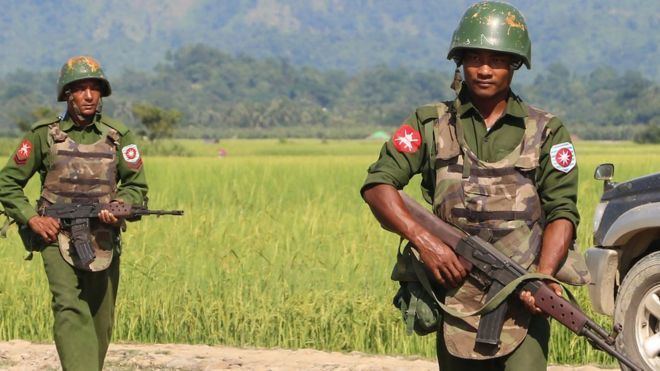 | ||
Similar | ||
The Myanmar Army (Burmese: တပ်မတော်(ကြည်း), [taʔmədɔ̀ tɕí]) is the largest branch of the Armed Forces (Tatmadaw) of Myanmar (Burma) and has the primary responsibility of conducting land-based military operations. The Myanmar Army maintains the second largest active force in Southeast Asia after the People's Army of Vietnam.
Contents
- Post Independence era
- Formation and structure
- Organization
- Expansion
- Chief of Staff and Commander in Chief of Myanmar Army from 1945 onwards
- Bureau of Special Operations BSO
- Regional Military Commands RMC
- Regional Operations Commands ROC
- Military Operations Commands MOC
- Light Infantry Divisions LID
- Missile Artillery and armoured units
- No1 Missile Operational Command MOC1
- Directorate of Artillery
- Artillery Operations Command AOC
- Directorate of Armour
- Armoured Operations Command AROC
- Bureau of Air Defence
- Sector Operations Commands
- Directorate of Signal
- Directorate of Medical Services
- Training
- Ranks and insignia
- Commissioned officers
- Non Commissioned Officers NCOs
- References

The Myanmar Army had a troop strength of around 350,000 as of 2006. The army has extensive combat experience in fighting insurgents in rough terrains, considering it has been conducting non-stop counter-insurgency operations against ethnic and political insurgents since its inception in 1948.
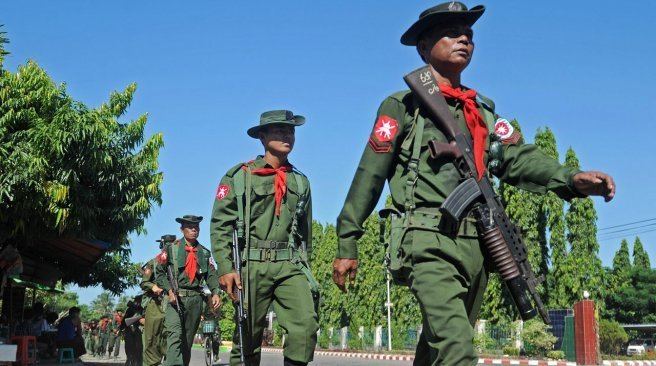
The force is headed by the Commander in Chief (Army) (ကာကွယ်ရေးဦးစီးချုပ်(ကြည်း)), currently Vice-Senior General Soe Win, concurrently Deputy Commander-in-Chief of the Defence Services, with Senior General Min Aung Hlaing as the Commander-in-Chief (တပ်မတော်ကာကွယ်ရေးဦးစီးချုပ်). The highest rank in the Myanmar Army is Senior General, equivalent to Field Marshal position in Western Armies and is currently held by Min Aung Hlaing after being promoted from Vice-Senior General.
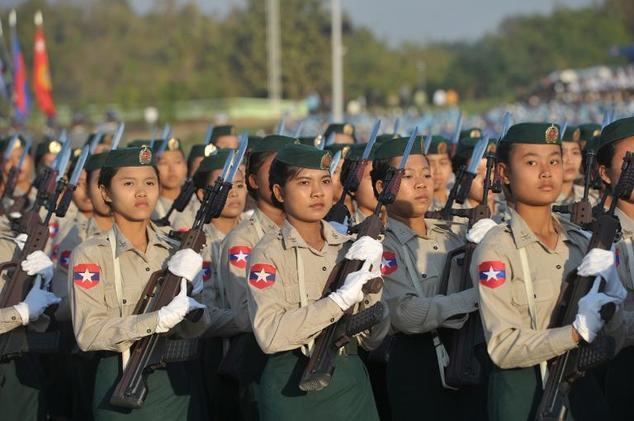
In 2011, following transition from military junta government to civilian parliamentary government, the Myanmar Army enacted a military draft for all citizens, all males from the age 18 to 35 and all females age between 18 and 27 years of age can be drafted into military service for two years as enlisted personnel in time of national emergency. The ages for professionals are up to 45 for men and 35 for women for three years service as commissioned and non commissioned officers.
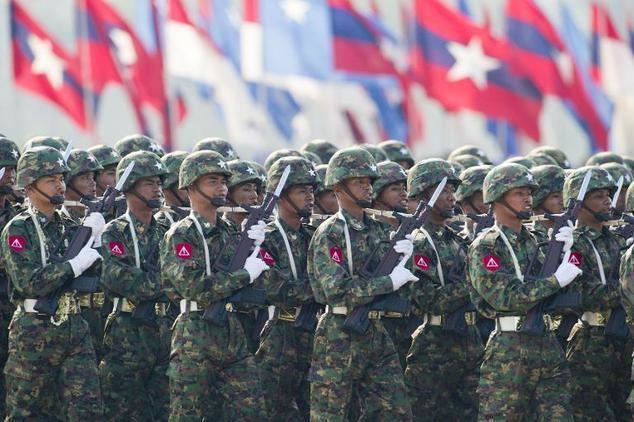
An official publication has revealed that almost one-quarter of Myanmar's new national budget will be allocated to defence. The Government Gazette reports that 1.8 trillion kyat (about $2 billion at free market rates of exchange), or 23.6 percent of the 2011 budget will go to defence.
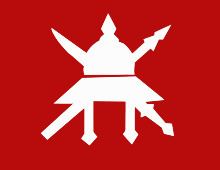
Post Independence era
At the time of Myanmar's independence in 1948, the Tatmadaw was weak, small and disunited. Cracks appeared along the lines of ethnic background, political affiliation, organisational origin and different services. Its unity and operational efficiency was further weakened by the interference of civilians and politicians in military affairs, and the perception gap between the staff officers and field commanders. The most serious problem was the tension between ethnic Karen Officers, coming from the British Burma Army and Bamar officers, coming from the Patriotic Burmese Forces (PBF).
In accordance with agreement reached at Kandy Conference in September 1945, the Tatmadaw was reorganised by incorporating the British Burma Army and the Patriotic Burmese Forces. The officer corps shared by ex-PBF officers and officers from British Burma Army and Army of Burma Reserve Organisation (ARBO). The British also decided to form what were known as "Class Battalions" based on ethnicity. There were a total of 15 rifle battalions at the time of independence and four of them were made up of former members of PBF. All influential positions within the War Office and commands were manned with non-former PBF Officers. All services including military engineers, supply and transport, ordnance and medical services, Navy and Air Force were all commanded by former Officers from ABRO and British Burma Army.
Formation and structure
The Army has always been by far the largest service in Myanmar and has always received the lion's share of the defence budget. It has played the most prominent part in Myanmar's struggle against the 40 or more insurgent groups since 1948 and acquired a reputation as a tough and resourceful military force. In 1981, it was described as 'probably the best army in Southeast Asia, apart from Vietnam's'. The judgement was echoed in 1983, when another observer noted that "Myanmar's infantry is generally rated as one of the toughest, most combat seasoned in Southeast Asia". In 1985, a foreign journalist with the rare experience of seeing Burmese soldiers in action against ethnic insurgents and narco-armies was 'thoroughly impressed by their fighting skills, endurance and discipline'. Other commentators throughout that time characterised the Myanmar Army as 'the toughest, most effective light infantry jungle force now operating in Southeast Asia'. Even the Thai people, not known to praise the Burmese lightly, have described the Myanmar Army as 'skilled in the art of jungle warfare'.
Organization
Myanmar Army had reached some 370,000 active troops in all ranks in the year 2000. There were 337 infantry battalions, including 266 light infantry battalions. Although the Myanmar Army's organisational structure was based upon the regimental system, the basic manoeuvre and fighting unit is the battalion, known as Tat Yinn ((တပ်ရင်း)) in Burmese. This comprised a headquarters unit; five rifle companies Tat Khwe ((တပ်ခွဲ)) with three rifle platoons Tat Su ((တပ်စု)) each; an administration company with medical, transport, logistics and signals units; a heavy weapons company including mortar, machine gun and recoilless gun platoons. Each battalion is commanded a Lieutenant Colonel Du Ti Ya Bo Hmu Gyi or Du Bo Hmu Gyi with a Major (bo hmu) as 2IC (Second in Command), with a total establishment strength of 27 officers and 723 other ranks. Light infantry battalions in the Myanmar Army have much lower establishment strength of around 500; this often leads to these units being mistakenly identified by the observers and reporters as under strength infantry battalions.
With its significantly increased personnel numbers, weaponry and mobility, today's Tatmadaw Kyee (တပ်မတော်(ကြည်း)) is a formidable conventional defence force for the Union of Myanmar. Troops ready for combat duty have at least doubled since 1988. Logistics infrastructure and Artillery Fire Support has been greatly increased. Its newly acquired military might was apparent in the Tatmadaw's dry season operations against Karen National Union (KNU) strongholds in Manerplaw and Kawmura. Most of the casualties at these battles were the result of intense and heavy bombardment by the Tatmadaw Kyee. The Tatmadaw Kyee is now much larger than it was before 1988, it is more mobile and has greatly improved armour, artillery and air defence inventories. Its C3I (Command, Control, Communications, Computers and Intelligence) systems have been expanded and refined. It is developing larger and more integrated, self-sustained formations to better coordinated action by different combat arms. The army may still have relatively modest weaponry compared to its larger neighbours, but it is now in a much better position to deter external aggression and respond to such a threat should it ever arise, although child soldiers may not perform very well in combating with enemies.
Expansion
The first army division to be formed after the 1988 military coup was the 11th Light Infantry Division (LID) in December 1988 with Colonel Win Myint as commander of the division. In March 1990, a new regional military command was opened in Monywa with Brigadier Kyaw Min as commander and named North-Western Regional Military Command. A year later 101st LID was formed in Pakokku with Colonel Saw Tun as commander. Two Regional Operations Commands (ROC) were formed in Myeik and Loikaw to facilitate command and control. They were commanded respectively by Brigadier Soe Tint and Brigadier Maung Kyi. March 1995 saw a dramatic expansion of the Tatmadaw as it established 11 Military Operations Commands (MOC)s in that month. MOC are similar to Mechanised Infantry Divisions in western armies, each with 10 regular infantry battalions (Chay Hlyin Tatyin), a headquarters, and organic support units including field artillery batteries. Then in 1996, two new RMC were opened, Coastal Region RMC was opened in Myeik with Brigadier Sit Maung as commander and Triangle Region RMC in Kengtung with Brigadier Thein Sein as commander. Their new ROCs were opened in Kalay, Bhamo and Mongsat. In late 1998, two new MOCs were opened in Bokepyin and Mongsat.
The most significant expansion after the infantry in the army was in armour and artillery. Beginning in 1990, the Tatmadaw procured 18 T-69II Main Battle tanks and 48 T-63 amphibious light tanks from China. Further procurements were made, including several hundred Type 85 and Type 92 Armoured Personnel Carriers (APC). By the beginning of 1998, Tatmadaw had about 100+ T-69II Main battle tanks, a similar number of T-63 amphibious light tanks and several T-59D tanks. These tanks and armoured personnel carriers were distributed into five armoured infantry battalions and five tank battalions and formed the first Armoured Division of the Tatmadaw under the name of 71st Armoured Operations Command with its headquarters in Pyawbwe.
Chief of Staff and Commander in Chief of Myanmar Army (from 1945 onwards)
Up until 1990, Myanmar Armed Forces has Chief of Staff system and Myanmar Army was led by Vice Chief of Staff (Army). A new system was introduced in 1990 during Armed Forces reorganisation and all three branches of Armed Forces are now led by the Commander-in-Chief.
Bureau of Special Operations (BSO)
Bureau of Special Operations (ကာကွယ်ရေးဌာန စစ်ဆင်ရေး အထူးအဖွဲ့) in Myanmar Army are high-level field units equivalent to Field Army in Western terms and consist of 2 or more Regional Military Commands (RMC) and commanded by a Lieutenant-General and 6 staff officers. The units were introduced under the General Staff Office on 28 April 1978 and 1 June 1979. In early 1978, the then Chairman of BSPP General Ne Win visited the North Eastern Command Headquarters in Lashio to receive a briefing about Burmese Communist Party (BCP) insurgents and their military operations. He was accompanied by Brigadier General Tun Ye from Ministry of Defence. Brigadier General Tun Ye was the regional commander of Eastern Command for three years and before that he served in North Eastern Command areas as commander of Strategic Operation Command (SOC) and commander for Light Infantry Division for four years. As BCP military operations were spread across three Regional Military Command (RMC) areas (Northern, Eastern and North Eastern), Brigadier General Tun Ye was the most informed commander about the BCP in Myanmar Army at the time. At the briefing, General Ne Win was impressed by Brigadier General Tun Ye and realised that co-ordination among various Regional Military Commands (RMC) was necessary; thus, decided to form a bureau at the Ministry of Defence. Originally, the bureau was for "special operations", wherever they were, that needed co-ordination among various Regional Military Commands (RMC). Later, with introduction of another bureau, there was a division of command areas. The BSO-1 was to oversee the operations under the Northern Command, North Eastern Command, the Eastern Command, and the North Western Command. BSO-2 was to oversee operations under the South Eastern Command, South Western Command, Western Command and Central Command. Initially, the chief of the BSO had the rank of Brigadier General. The rank was upgraded to Major General on 23 April 1979. in 1990, it was further upgraded to Lieutenant General. Between 1995 and 2002, Chief of Staff (Army) jointly held the position of Chief of BSO. However, in early 2002, two more BSO were added to the General Staff Office; therefore there were altogether four BSOs. The fifth BSO was established in 2005 and the sixth in 2007.
Currently there are Six Bureaus of Special Operations in Myanmar order of Battle.
Regional Military Commands (RMC)
For better command and communication, the Tatmadaw formed Regional Military Commands (တိုင်း စစ်ဌာနချုပ်) structure in 1958. Until 1961, there were only two regional commands, they were supported by 13 Infantry brigades and an infantry division. In October 1961, new regional military commands were opened and leaving only two independent infantry brigades. In June 1963, the Naypyidaw Command was temporarily formed in Yangon with the deputy commander and some staff officers drawn from Central Command. It was reorganised and renamed as Yangon Command on 1 June 1965.
A total of 337 infantry and light infantry battalions organised in Tactical Operations Commands, 37 independent field artillery regiments supported by affiliated support units including armoured reconnaissance and tank battalions. RMCs are similar to corps formations in Western armies. The RMCs, commanded by Major General rank officer, are managed through a framework of Bureau of Special Operations (BSOs), which are equivalent to Field Army Group in Western terms.
Regional Operations Commands (ROC)
Regional Operations Commands (ROC)(ဒေသကွပ်ကဲမှု စစ်ဌာနချုပ်) are commanded by a Brigadier General, are similar to infantry brigades in Western Armies. Each consists of 4 Infantry battalions (Chay Hlyin Tatyin), HQ and organic support units. Commander of ROC is a position between LID/MOC commander and tactical Operation Command (TOC) commander, who commands three infantry battalions. The ROC commander holds financial, administrative and judicial authority while the MOC and LID commanders do not have judicial authority.
Military Operations Commands (MOC)
Military Operations Commands (MOC) (စစ်ဆင်ရေး ကွပ်ကဲမှု ဌာနချုပ် (စကခ)), commanded by a Brigadier-General are similar to Infantry Divisions in Western Armies. Each consists of 10 Mechanised Infantry battalions equipped with BTR-3 armoured personnel carriers, Headquarters and support units including field artillery batteries. These ten battalions are organised into three Tactical Operations Commands: one Mechanised Tactical Operations Command with BTR-3 armoured personnel carriers, and two Motorized Tactical Operations Command with EQ-2102 6x6 trucks.
MOC are equivalent to Light Infantry Divisions (LID) in the Myanmar Army order of battle as both command 10 infantry battalions through three TOC's (Tactical Operations Commands). However, unlike Light Infantry Divisions, MOC are subordinate to their respective Regional Military Command (RMC) Headquarters. Members of MOC does not wear distinguished arm insignias and instead uses their respective RMC's arm insignias. For example, MOC-20 in Kawthaung wore the arm insignia of Costal Region Military Command.
Light Infantry Divisions (LID)
Light Infantry Division (Chay Myan Tat Ma or Ta Ma Kha), commanded by a Brigadier General, each with 10 Light Infantry Battalions organised under 3 Tactical Operations Commands, commanded by a Colonel, (3 battalions each and 1 reserve), 1 Field Artillery Battalion, 1 Armour Squadron and other support units.
These divisions were first introduced to the Myanmar Army in 1966 as rapid reaction mobile forces for strike operations. 77th Light Infantry Division was formed on 6 June 1966, followed by 88th Light Infantry Division and 99th Light Infantry Division in the two following years. 77th LID was largely responsible for the defeat of the Communist forces of the CPB (Communist Party of Burma) based in the forested hills of the central Bago Mountains in the mid-1970s. Three more LIDs were raised in the latter half of the 1970s (the 66th, 55th and 44th) with their headquarters at Pyay, Aungban and Thaton. They were followed by another two LIDs in the period prior to the 1988 military coup (the 33rd LID with headquarters at Sagaing and the 22nd LID with headquarters at Hpa-An). 11th LID was formed in December 1988 with headquarters at Inndine, Bago Division and 101st LID was formed in 1991 with its headquarters at Pakokku.
Each LID, commanded by Brigadier General (Bo hmu gyoke) level officers, consists of 10 light infantry battalions specially trained in counter-insurgency, jungle warfare, "search and destroy" operations against ethnic insurgents and narcotics-based armies. These battalions are organised under three Tactical Operations Commands (TOC; Nee byu har). Each TOC, commanded by a Colonel (Bo hmu gyi), is made up of three or more combat battalions, with command and support elements similar to that of brigades in Western armies. One infantry battalion is held in reserve. As of 2000, all LIDs have their own organic Field Artillery units. For example, 314th Field Artillery Battery is now attached to 44th LID. Some of the LID battalions have been given Parachute and Air Borne Operations training and two of the LIDs have been converted to mechanised infantry formation with divisional artillery, armoured reconnaissance and tank battalions
LIDs are considered to be a strategic asset of the Myanmar Army, and after the 1990 reorganisation and restructuring of the Tatmadaw command structure, they are now directly answerable to Chief of Staff (Army).
Missile, Artillery and armoured units
Missile, Artillery and armoured units were not used in an independent role, but were deployed in support of the infantry by the Ministry of Defence as required. The Directorate of Artillery and Armour Corps was also divided into separate corps in 2001. The Directorate of Artillery and Missile Corps was also divided into separate corps in 2009. A dramatic expansion of forces under these directorates followed with the equipment procured from China, Russia, Ukraine and India.
No(1) Missile Operational Command MOC(1)
Directorate of Artillery
No. 1 Artillery Battalion was formed in 1952 with three artillery batteries under the Directorate of Artillery Corps. A further three artillery battalions were formed in the late 1952. This formation remained unchanged until 1988. Since 2000, the Directorate of Artillery Corps has overseen the expansion of Artillery Operations Commands(AOC) from two to 10. Tatmadaw's stated intention is to establish an organic Artillery Operations Command in each of the 12 Regional Military Command Headquarters. Each Artillery Operation Command is composed of the following:
As of 2000, the Artillery wing of the Tatmadaw has about 60 battalions and 37 independent Artillery companies/batteries attached to various Regional Military Commands (RMC), Light Infantry Divisions (LID), Military Operation Command (MOC) and Regional Operation Command (ROC). For example, 314th Artillery Battery is under 44th LID, 326 Artillery Battery is attached to 5th MOC, 074 Artillery Battery is under the command of ROC (Bhamo) and 076 Artillery Battery is under North-Eastern RMC. Twenty of these Artillery battalions are grouped under 707th Artillery Operation Command (AOC) headquarters in Kyaukpadaung and 808th Artillery Operation Command (AOC) headquarters in Oaktwin, near Taungoo. The remaining 30 battalions, including 7 Anti-Aircraft artillery battalions are under the Directorate of Artillery Corps.
Artillery Operations Command (AOC)
Light field artillery battalions consists of 3 field artillery batteries with 36 field guns or howitzers (12 guns per battery). Medium artillery battalions consists of 3 medium artillery batteries of 18 field guns or howitzers (6 guns per one battery). As of 2011, all field guns of Myanmar Artillery Corps are undergoing upgrade programs including GPS Fire Control Systems.
Directorate of Armour
No. 1 Armour Company and No. 2 Armour Company were formed in July 1950 under the Directorate of Armour and Artillery Corps with Sherman tanks, Stuart light tanks, Humber Scout Cars, Ferret armoured cars and Universal Bren Carriers. These two companies were merged on 1 November 1950 to become No. 1 Armour Battalion with Headquarters in Mingalardon. On 15 May 1952 No. Tank Battalion was formed with 25 Comet tanks acquired from the United Kingdom. The Armour Corps within Myanmar Army was the most neglected one for nearly thirty years since the Tatmadaw had not procured any new tanks or armoured carriers since 1961.
Armoured divisions, known as Armoured Operations Command (AROC), under the command of Directorate of Armour Corps, were also expanded in number from one to two, each with four Armoured Combat battalions equipped with Infantry fighting vehicles and armoured personnel carriers, three tank battalions equipped with main battle tanks and three Tank battalions equipped with light tanks. In mid-2003, Tamadaw acquired 139+ T-72 main battle tanks from Ukraine and signed a contract to build and equip a factory in Myanmar to produce and assemble 1,000 BTR armoured personnel carriers in 2004. In 2006, the Government of India transferred an unspecified number of T-55 main battle tanks that were being phased out from active service to Tatmadaw along with 105 mm light field guns, armoured personnel carriers and indigenous HAL Light Combat Helicopters in return for Tatmadaw’s support and co-operation in flushing out Indian insurgent groups operating from its soil.
Armoured Operations Command (AROC)
Armoured Operations Commands (AROC) are equivalent to Independent armoured divisions in western terms. Currently there are 5 Armoured Operations Commands under Directorate of Armoured Corps in the Tatmadaw order of battle. Tatmadaw planned to establish an AROC each in 7 Regional Military Commands. Typical armoured divisions in the Myanmar Army are composed of Headquarters, Three Armored Tactical Operations Command – each with one mechanised infantry battalion equipped with 44 BMP-1 or MAV-1 Infantry Fighting Vehicles, Two Tank Battalions equipped with 44 main battle tanks each, one armoured reconnaissance battalion equipped with 32 Type-63A Amphibious Light Tanks, one field artillery battalion and a support battalion. The support battalion is composed of an engineer squadron, two logistic squadrons, and a signal company.
The Myanmar Army acquired about 150 refurbished EE-9 Cascavel armoured cars from an Israeli firm in 2005. Classified in the army's service as a light tank, the Cascavel is currently deployed in the eastern Shan State and triangle regions near the Thai border.
Bureau of Air Defence
The Air Defence Command was formed during the late 1990s but was not fully operational until late 1999. It was renamed Bureau of Air Defence in the early 2000s (decade). In early 2000, Tatmadaw established Myanmar Integrated Air Defence System (MIADS) with help from Russia, Ukraine and China. It is a tri-service bureau with units from all three branches of Myanmar Armed Forces. All Air Defence assets except Anti-Aircraft Artillery within Tatmadaw arsenal are integrated into MIADS. AAA guns are mostly unguided and deploy to use in barrage-style firing against attacking aircraft. MIADS is directly answerable to Bureau of Air Defence under Ministry of Defence.
In 2010, Myanmar Air Defence Command has completed installation of optical fibre communication network throughout the country. Those network are to be used for Air defence operations between Central Command HQ from capital & several air bases, early warning radar stations & mobile anti air craft missile & artillery units. After completion of fibre optic project & radar stations, MIADS (Myanmar Integrated Air Defence System) becomes the most advance AD system in the region.
Sector Operations Commands
Under MIADS, the country was divided into six Air Defence Sectors, each controlled by a Sector Operations Center (SOC) and reporting directly to the National Air Defence Operations Centre (ADOC) in Yangon. Each SOC transmitted data back to Intercept Operations Centers (IOC), which in turn controlled surface-to-air missile batteries and fighter/interceptor squadrons at various Air Bases. Each IOC was optimised to direct either SAMs or fighter/interceptor aircraft against incoming enemy aircraft or missile. Each IOC was connected to observer and early warning area reporting posts (RP) via military owned underground fibre optic cable network. There were about 100 radar stations located at approximately 40 sites throughout the country. New Air Defence radars such as 1L117 radars, Galaxy Early Warning Radar and P series radars are installed in all radar stations.
Each Sector Operation Center (SOC) is commanded by a Major General and it consists of one air defence division from Myanmar Army and one fighter-interceptor wing from Myanmar Air Force. Sometimes Air Defence Frigates from Myanmar Navy also operate under the direct command of respective SOC.
Each Air Defence division is commanded by a Brigadier General and consists of three Air Defence Tactical Operations Command (TOC) and support units. One Medium Range Surface to Air Missile Tactical Operations Command (MRSAM-TOC), with three battalions equipped with Buk M-1 or Kub missile system is deployed in an Area Defence Belt role. One Short Range Air Defence Tactical Operations Command (SHORAD-TOC), with three battalions equipped with Tor M-1 missile system is deployed in a Point Defence role for critical areas such as radar stations, fighter bases and SOC headquarters. One Electronic Reconnaissance Tactical Operations Command (EIR-TOC) with 6 to 8 radar and communication companies for early warnings and interdiction detection.
Each fighter-interceptor wing commanded by a Brigadier General and is composed of three Fighter squadrons of either MiG-29 and F-7M AirguardiInterceptors (ten aircraft per squadron) and their ground base support units.
Directorate of Signal
Soon after the independence in 1948, Myanmar Signal Corps was formed with units from Burma Signals, also known as "X" Branch. It consisted HQ Burma Signals, Burma Signal Training Squadron (BSTS) and Burma Signals Squadron. HQ Burma Signals was located within War Office. BSTS based in Pyain Oo Lwin was formed with Operating Cipher Training Troop, Dispacth Rider Training Troop, Lineman Training Troop, Radio Mechanic Training Troop and Regimental Signals Training Troop. BSS, based in Mingalardon, had nince sections: Administration Troop, Maintenance Troop, Operating Troop, Cipher Troop, Lineman and Dispatch Rider Troop, NBSD Singals Troop, SBSD Signals Troop, Mobile Brigade Singals Toop and Arakan Singals Toop. The then Chief of Signal Staff Officer (CSO) was Lieutenant Colonel Saw Aung Din. BSTS and BSS were later renamed No. 1 Signal Battalion and No.1 Signal Training Battalion. In 1952, the Infantry Divisional Signals Regiment was formed and later renamed to No. 2 Signal Battalion. HQ Burma Signals was reorganised and became Directorate Signal and the director was elevated to the rank of Colonel. In 1956, No. 1 Signal Security Battalion was formed, followed by No. 3 Signal Battalion in November 1958 and No.4 Signal Battalion in October 1959.
In 1961, signal battalions were reorganised as No. 11 Signal Battalion under North Eastern Regional Military Command, No. 121 Signal Battalion under Eastern Command, No. 313 Signal Battalion under Central Command, No.414 Signal Battalion under South Western Command, and No. 515 Signal Battalion under South Eastern Command. No.1 Signal Training Battalion was renamed Burma Signal Training Depot (Baho-Setthweye-Tat).
By 1988, Directorate of Signals command one training depot, eight signal battalions, one signal security battalion, one signal store depot and two signal workshops. Signal Corps under Directorate of Signal further expanded during 1990 expansion and reorganisation of Myanmar Armed Forces. By 2000, a signal battalion is attached to each Regional Military Command and signal companies are now attached to Light Infantry Divisions and Military Operations Commands.
In 2000, Command, Control and Communication system of Myanmar Army has been substantially upgraded by setting up the military fibre optic communication network managed by Directorate of Signal throughout the country. Since 2002 all Myanmar Army Regional Military Command HQs used its own telecommunication system. Satellite communication links are also provided to forward-deployed infantry battalions. However, battle field communication systems are still poor. Infantry units are still using TRA 906 and PRM 4051 which were acquired from UK in the 1980s. Myanmar Army also uses the locally built TRA 906 Thura and Chinese XD-D6M radio sets. Frequency hopping handsets are fitted to all front line units.
Between 2000 and 2005, Myanmar army bought 50 units of Brett 2050 Advanced Tech radio set from Aussie through third party from Singapore. Those units are distributed to ROCs in central & upper regions to use in counterinsurgency operations.
Directorate of Medical Services
At the time of independence in 1948, the medical corps has two Base Military Hospitals, each with 300 beds, in Mingalardon and Pyin Oo Lwin, a Medical Store Depot in Yangon, a Dental Unit and six Camp Reception Stations located in Myitkyina, Sittwe, Taungoo, Pyinmana, Bago and Meikhtila. Between 1958 and 1962, the medical corps was restructred and all Camp Reception Stations were reorganised into Medical Battalions.
In 1989, Directorate of Medical Services has significantly expanded along with the infantry. In 2007, there are two 1,000-bed Defence Services General Hospitals (Mingalardon and Naypyitaw), two 700-bed hospitals in Pyin Oo Lwin and Aung Ban, two 500-bed military hospitals in Meikhtila and Yangon, one 500-bed Defence Services Orthopedic Hospital in Mingalardon, two 300-bed Defence Services Obstetric, Gynecological and Children hospitals (Mingalardon and Naypyitaw), three 300-bed Military Hospitals (Myitkyina, Ann and Kengtung), eighteen 100-bed Military Hospitals (Mongphyet, Baan, Indaing, Bahtoo, Myeik, Pyay, Loikaw, Namsam, Lashio, Kalay, Mongsat, Dawai, Kawthaung, Laukai, Thandaung, Magway, Sittwe, and Hommalin), fourteen field medical battalions, which are attached to various Regional Military Commands throughout the country. Each Field Medical Battalion consist of 3 Field Medical Companies with 3 Field Hospital Units and a specialist team each. Health & Disease Control Unit (HDCU) is responsible for prevention, control & eradication of diseases.
Training
See: Military Training in MyanmarRanks and insignia
See: Army ranks and insignia of MyanmarThe various rank of the Myanmar Army are listed below in descending order:
Commissioned officers
Note: Senior General (OF-10) is the highest rank in Myanmar Armed Forces and Vice Senior General/Admiral in the Army, Navy, Air Force, Bureau of Air Defence, Chief of Staff, Adjutant General, Quartermaster General and Bureau of Special Operations.
Non-Commissioned Officers (NCOs)
Non-commissioned officers are referred to as Saya(ဆရာ), meaning Teacher, by both enlisted men and officers. For example, Warrant Officers, Regimental Sergeant Majors and Master Sergeant are referred to as Sayagyi (ဆရာကြီး), literally meaning "Old Teacher", Sergeant are referred to as Saya and Corporal/Lance Corporal as Sayalay(ဆရာလေး). These unofficial ranks are used throughout the daily life of all branches. Non-Commissioned Officers (NCO) within the Myanmar Armed Forces are usually seasoned veteran soldiers. Thus both Officers and enlisted men refer to them as "teacher" out of respect.
